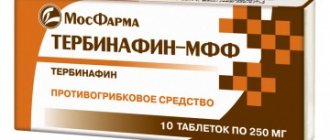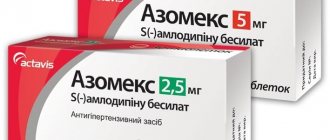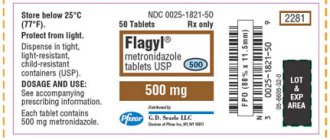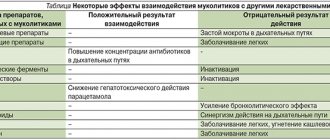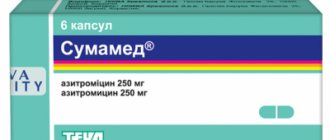pharmachologic effect
An antifungal drug for external use with a wide spectrum of antifungal activity. In small concentrations, terbinafine has a fungicidal effect against dermatophytes (Trychophyton rubrum, Trychophyton mentagrophytes, Trychophyton verrucosum, Trychophyton violaceum, Trychophyton tonsurans, Microsporum canis, Epidermophyton floccosum), yeast fungi (mainly Candida albicans) and certain dimorphic fungi (Pityrosporum orbiculare).
Activity against yeast-like fungi, depending on their type, can be fungicidal or fungistatic.
Terbinafine does not affect the metabolism of hormones or other drugs.
The minimum inhibitory concentration for Trychophyton rubrum is 0.001-0.06 μg/ml. For onychomycosis of the hands, the effectiveness of treatment is 95%, for onychomycosis of the feet - more than 90%. With chronic dermatophytosis of smooth skin, remission is achieved in 75-95% of patients. Subjective improvement in the treatment of progressive candidiasis of smooth skin and lesions of large and interdigital folds, paronychia, caused by Candida albicans and resistant to therapy with nystatin, levorin in combination with clotrimazole and miconazole, occurs within 3-4 days, and complete resolution of the process occurs after 3-5 weeks
Overdose symptoms
Accidental use of large quantities of Terbinafine tablets may cause:
- dermatological rash, cephalalgia;
- frequent urination;
- attacks of vomiting with dizziness;
- discomfort from the gastrointestinal tract.
Therapy includes gastric lavage with activated charcoal. In difficult cases, symptomatic treatment is prescribed.
There is no information in the annotation about cases of ointment overdose. These adverse reactions occur when an external agent is accidentally taken orally.
Contraindications
Hypersensitivity to terbinafine or to any of the inactive ingredients included in the drug.
Carefully
Renal/liver failure, alcoholism, suppression of bone marrow hematopoiesis, tumors, metabolic diseases, occlusive vascular diseases of the extremities, pregnancy, breastfeeding, children under 12 years of age (lack of sufficient clinical experience of use).
Use during pregnancy and breastfeeding
In experimental studies, teratogenic properties of terbinafine were not identified. To date, no malformations have been reported with the use of Terbinafine cream. However, since clinical experience with the use of Terbinafine cream in pregnant women is very limited, it should be used only for strict indications.
Terbinafine is excreted in breast milk. However, if a nursing mother uses Terbinafine cream, a small amount of the active substance is absorbed through the skin, so adverse effects on the baby are unlikely.
The cream should not be applied to the mammary glands during breastfeeding.
During pregnancy and breastfeeding, use only if the expected benefit to the mother outweighs the potential risk to the fetus or child.
Components of Terbinafine
The instructions indicate the following ingredients of the medication:
- Tablets - presented with terbinafine hydrochloride, lactose monohydrate, potato starch, talc, aerosil, magnesium stearate, MCC;
- Ointment - terbinafine hydrochloride, carbomer, vaseline oil, polysorbate, sodium hydroxide, water, propylene glycol, methyl parahydroxybenzoate.
Terbinafine is produced not only in ointments and tablets, but also in cream and spray. The choice of the appropriate form to combat fungal infection is the responsibility of the attending physician. External forms are used for mild lesions, oral forms for systemic infection.
special instructions
Irregular use or early termination of treatment increases the risk of relapse. If after 2 weeks of treatment there is no improvement in the condition, it is necessary to re-determine the causative agent of the disease and its sensitivity to the drug. During the treatment process, it is necessary to follow general hygiene rules to prevent reinfection (through underwear, shoes). Avoid contact with the mucous membrane of the eyes, nose, and mouth.
Impact on the ability to drive vehicles and operate machinery
During the period of treatment with the drug, it is possible to drive vehicles and engage in other potentially hazardous activities that require increased concentration and speed of psychomotor reactions.
Terbinafine
The drug is generally well tolerated. Side effects are usually mild or moderate and transient.
When assessing the frequency of side effects, the following gradations were used: “very often” (≥ 1/10), “often” (≥1/100 <1/10), “infrequently” (≥1/1000 <1/100), “ rarely" (≥1/10000 <1/1000), "very rarely" (<1/10000), including isolated reports.
Disorders of the hematopoietic system: infrequently - anemia, very rarely - neutropenia, agranulocytosis, thrombocytopenia, pancytopenia.
Immune system disorders: very rarely - anaphylactoid reactions (including angioedema), cutaneous and systemic lupus erythematosus (or their exacerbation).
Nervous system disorders: very often - headache; often - dizziness, disturbances in taste, up to their loss (usually recovery occurs within a few weeks after stopping treatment); infrequently - paresthesia, hypoesthesia. There are isolated reports of cases of long-term disturbances in taste. In some cases, while taking the drug, exhaustion was noted.
Mental disorders: often - depression; infrequently - anxiety.
Visual disturbances: infrequently - visual disturbances.
Hearing and labyrinthine disorders: uncommon - tinnitus.
Disorders of the liver and biliary tract: rarely - hepatobiliary dysfunction (mainly of cholestatic nature), incl. liver failure, including very rare cases of severe liver failure (some fatal or requiring liver transplantation; in most cases where liver failure developed, the patients had serious underlying systemic diseases and the causal relationship of liver failure to terbinafine was questionable), hepatitis, jaundice, cholestasis, increased activity of liver enzymes.
Disorders of the digestive system: very often - bloating, loss of appetite, dyspepsia, nausea, mild abdominal pain, diarrhea.
Disorders of the skin and subcutaneous tissues: very often - rash, urticaria, infrequently - photosensitivity reactions; very rarely - Stevens-Johnson syndrome, toxic epidermal necrolysis, acute generalized exanthematous pustulosis, erythema multiforme, toxic skin rash, exfoliative dermatitis, bullous dermatitis, psoriasis-like skin rashes or exacerbations of psoriasis, alopecia.
Musculoskeletal and connective tissue disorders: very often - arthralgia, myalgia.
General disorders: often - feeling of fatigue; infrequently - increased body temperature.
Laboratory and instrumental data: infrequently - loss of body weight (secondary to a disturbance in the sense of taste).
Based on spontaneous reports received during the post-registration period and literature data, the following adverse events were identified, the frequency of which, due to the inaccurate number of patients, cannot be established:
Immune system disorders: anaphylactic reactions, serum sickness-like syndrome.
Visual disturbances: blurred vision, decreased visual acuity.
Skin and subcutaneous tissue disorders: drug rash with eosinophilia and systemic symptoms (rash, swelling, fever, and swollen lymph nodes).
Hearing and labyrinthine disorders: hearing loss, hearing impairment.
Vascular disorders: vasculitis.
Nervous system disorders: loss of smell, including for a long period of time, decreased sense of smell.
Digestive system disorders: pancreatitis.
Disorder of the musculoskeletal and connective tissue side: rhabdomyolysis.
General disorders: influenza-like syndrome.
Blood and lymphatic system disorders: anemia.
Laboratory and instrumental data: increased activity of creatine phosphokinase in blood plasma.
If any of the side effects indicated in the instructions get worse, or you notice any other side effects not listed in the instructions, tell your doctor.
Directions for use and doses
Externally.
Adults and children over 12 years of age: apply the cream to the affected skin and adjacent areas in a thin layer, lightly rubbing, 1 or 2 times a day. The duration of treatment depends on the indication and severity of the disease. The course of treatment is on average 2-4 weeks. Duration and frequency of use: dermatomycosis of the trunk, legs, feet - 1 time per day for 1 week; skin candidiasis - 1-2 times a day for 1-2 weeks; lichen versicolor - 1-2 times a day for 2 weeks.
Interaction with other drugs
Combination with foreign drugs provokes:
- influence on the clearance of drugs - Cyclosporine, oral contraceptives, Tolbutamide;
- increased concentration of histamine blockers in the blood;
- slowing down the excretion of Rifampicin;
- changes in the menstrual cycle - when combined with oral contraceptives.
Drug-induced liver damage occurs when taken with hepatotoxic drugs or ethanol.
Indications for use
The instructions for the use of Terbinafine indicate that all forms of the drug are used for diseases that were caused by yeast-like , molds , and dermatophytes .
The drug in tablets is indicated for use in diseases of fungal origin that were caused by dermatophytes of the genus Trichophyton (T. Mentagrophytes, T. verrucosum, T. Violaceum, T. Rubrum, T. tonsurans), Microsporum canis, Epidermophyton floccosum, as well as fungi of the genus Candida. Tablets are prescribed for trichophytosis , microsporia , onychomycosis , epidermophytosis , candidiasis .
As a rule, Terbinafine tablets are prescribed for widespread and severe symptoms. At the same time, treating lichen versicolor with tablets is ineffective.
What the cream, ointment and spray are for, and whether these local remedies should be used, should be determined by a specialist.
As a rule, the cream should be used for fungal diseases caused by Candida, Microsporum canis, Trichophyton, Pityriasis, Epidermophyton floccosum fungi.
Also, ointment and cream are used for candidiasis, skin lesions caused by dermatophytes, and lichen versicolor.
Compound
Terbinafine tablets contain the active substance terbinafine hydrochloride , as well as additional components: MCC, lactose monohydrate, potato starch, talc, primellose, aerosil, magnesium stearate.
Terbinafine cream contains the active component terbinafine hydrochloride , as well as additional components: benzyl alcohol, stearic acid, distilled glycerol, petrolatum, emulsifier, water, triethanolamine.
The ointment contains the active component terbinafine hydrochloride , as well as additional components: methyl parahydroxybenzoate, carbomer , petroleum jelly, polysorbate, sodium hydroxide, propylene glycol, water.
Terbinafine spray contains the active component terbinafine hydrochloride , as well as additional components: macrogol 400 , water, propylene glycol, ethyl alcohol.
Side effects
When taking pills, patients may experience the following side effects:
- feeling of pain and weakness in the epigastric region;
- loss of appetite;
- cholestasis;
- taste disturbance;
- allergic reactions;
- nausea;
- diarrhea;
- decreased levels of platelets and neutrophils in the blood.
When applied topically, itching, burning and hyperemia may occur in the areas where the product was applied. Allergic manifestations may develop in rare cases.
